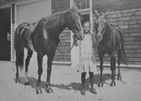About Us

The Science Museum of Long Island (SMLI) is a cherished non-profit organization dedicated to providing hands-on science education since its inception in 1962. Located in the heart of Long Island, SMLI has been a beacon of knowledge and curiosity for young minds, offering a wide range of interactive learning experiences designed to spark joy and excitement in the pursuit of scientific understanding.
At SMLI, our mission is to captivate and inspire children, encouraging them to explore the wonders of science through engaging and immersive activities. Our programs are meticulously crafted to evoke a sense of wonder and discovery, fostering a lifelong love for exploration and learning. Over the decades, we have had the honor of influencing multiple generations, helping shape their scientific knowledge and nurturing their inquisitive spirits.
From dynamic workshops and educational camps to scout badges, birthday parties and special events, SMLI provides a unique environment where children can engage with science in a hands-on, meaningful way. Our commitment to excellence in science education has made us a trusted resource for families and educators alike, continually evolving to meet the needs of our community. Join us at the Science Museum of Long Island, where learning is an adventure and every child’s curiosity is the key to unlocking the mysteries of the world.

GENERAL INFORMATION:
** CLASSES AT THE SCIENCE MUSEUM ARE PRE-REGISTRATION. WE DO NOT HAVE ANY EXHIBITS THAT ARE OPEN TO THE PUBLIC.
HOURS OF OPERATION:
SMLI BUILDINGS & ADMIN OFFICES:
MONDAY THROUGH FRIDAY
9 AM - 5 PM
LEEDS POND PRESERVE:
OPEN TO THE PUBLIC 7 DAYS A WEEK.
SUNRISE TO SUNSET.
PLEASE NOTE THAT BUILDINGS ARE NOT ALWAYS OPEN WHEN THE PRESERVE IS OPEN.
PARKING IS PROHIBITED AT THE PRESERVE AFTER DARK.
CONTACT:
516-627-9400
info@smli.org
ADDRESS:
1526 N. Plandome Road
Manhasset, NY 11030
OUR HISTORY
Leeds Pond Preserve is a 36-acre historic property encompassing diverse ecological landscape including forests, riparian wetlands, intertidal beaches, and a large open grass meadow rising about 60 feet above Manhasset Bay and serves as a springboard for the detailed investigation of local ecological habitats. Robert Sizer, a wealthy New York businessman, began construction of his family summer residence about 1903-1905 consisting of three historic buildings and several smaller structures that were designed in the late 19th-Century shingle style so popular on Long Island at that time. He called the summer estate Norwood.
In 1927, maritime attorney Herman Goldman purchased Norwood as a family weekend country retreat. Goldman made major changes to the entire property. The main house was extensively remodeled and redecorated. The open farmland fields were landscaped. Additional, mostly forested, acreage was purchased from neighbors making his holdings a total of 36 acres with Manhasset Bay beaches to the west and Leeds Pond marshland to the south. Three structures are currently used by SMLI for its programs.
The preserve, which includes Leeds Pond, is named after Warner M. Leeds, who owned the pond from 1906 until his death in 1925.
THE START OF THE SCIENCE MUSEUM OF LONG ISLAND
In 1962, a small advertisement was placed in the local newspaper that read, "Anyone interested in organizing a Hands-On Science Museum in Long Island is invited to come to the home of DORIS LEONARD." Leonard believed that an understanding of scientific principles was essential for the U.S. to meet the challenges of the current times and the 20 Long Island residents and educators who responded to her ad agreed. All of them perceived a cultural and educational need in the community and within a few months, established the North Shore Junior Science Museum, the institution known today as the Science Museum of Long Island.
In 1963, the North Shore Junior Science Museum was chartered by the Board of Regents of the state of New York. Their original goal was to develop a non-profit participatory science activity center to provide a focused instructional setting for young people and to encourage inquiring minds by involving them in the excitement of scientific discovery.
During the first decade, activities were offered in a variety of locations. Recognizing the need for a stable base of operations they began to look for a permanent home. In 1973, the effort brought SMLI to its present location which was once the estate of Herman Goldman, an attorney and expert in maritime law. Located on the Leeds Pond Preserve, the landmark agreement was one of the first public-private partnerships in Nassau County, marking a relationship that has continued for seven decades and many administrations.
During the 1980's the name of the Museum was changed to the Science Museum of Long Island to reflect the wider geographic audience that programs had begun to attract. Today SMLI continues to build on the legacy of its founders and continues to fulfill its vital mission: the education of the scientists and citizens of today and tomorrow, emphasizing hands-on learning that is as fun and fascinating as it is informative.
60 YEARS OF SCIENCE EDUCATION
The Science Museum of Long Island provides a broad spectrum of quality science educational services throughout the tri-county area. Our programs emphasize experience based, hands-on learning allowing children the opportunity to really dig into the heart of science in a friendly, camp like setting. One aspect of the Museum’s uniqueness lies in its total commitment and ability to carefully tailor its programs to meet the specific needs of each group that we serve. Our friendly and enthusiastic staff bring science alive for all audiences. Here you can discover the analogies in bat wings and airplanes or the relationship between stars. Areas of scientific study range from anatomy to zoology and explore the world of one-celled life to telescopic observation of the grand sweep of the galaxy.



















